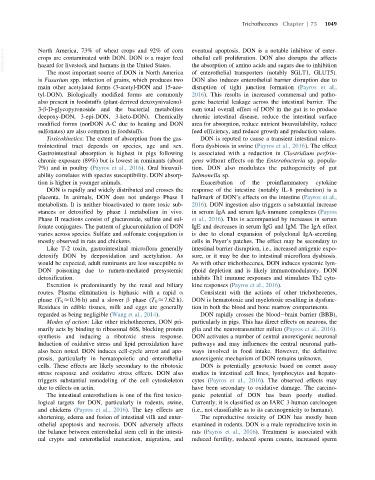Page 1117 - Veterinary Toxicology, Basic and Clinical Principles, 3rd Edition
P. 1117
Trichothecenes Chapter | 75 1049
VetBooks.ir North America, 73% of wheat crops and 92% of corn eventual apoptosis. DON is a notable inhibitor of enter-
othelial cell proliferation. DON also disrupts the affects
crops are contaminated with DON. DON is a major feed
hazard for livestock and humans in the United States.
the absorption of amino acids and sugars due to inhibition
The most important source of DON in North America of enterothelial transporters (notably SGLT1, GLUT5).
is Fusarium spp. infection of grains, which produces two DON also induces enterothelial barrier disruption due to
main other acetylated forms (3-acetyl-DON and 15-ace- disruption of tight junction formation (Payros et al.,
tyl-DON). Biologically modified forms are commonly 2016). This results in increased commensal and patho-
also present in foodstuffs (plant-derived dexoxynivalenol- genic bacterial leakage across the intestinal barrier. The
3-β-D-glycopyronoside and the bacterial metabolites sum total overall effect of DON in the gut is to produce
deepoxy-DON, 3-epi-DON, 3-keto-DON). Chemically chronic intestinal disease, reduce the intestinal surface
modified forms (norDON A-C due to heating and DON area for absorption, reduce nutrient bioavailability, reduce
sulfonates) are also common in foodstuffs. feed efficiency, and reduce growth and production values.
Toxicokinetics: The extent of absorption from the gas- DON is reputed to cause a transient intestinal micro-
trointestinal tract depends on species, age and sex. flora dysbiosis in swine (Payros et al., 2016). The effect
Gastrointestinal absorption is highest in pigs following is associated with a reduction in Clostridium perfrin-
chronic exposure (89%) but is lowest in ruminants (about gens without effects on the Enterobacteria sp. popula-
7%) and in poultry (Payros et al., 2016). Oral bioavail- tion. DON also modulates the pathogenicity of gut
ability correlates with species susceptibility. DON absorp- Salmonella sp.
tion is higher in younger animals. Exacerbation of the proinflammatory cytokine
DON is rapidly and widely distributed and crosses the response of the intestine (notably IL-8 production) is a
placenta. In animals, DON does not undergo Phase I hallmark of DON’s effects on the intestine (Payros et al.,
metabolism. It is neither bioactivated to more toxic sub- 2016). DON ingestion also triggers a substantial increase
stances or detoxified by phase I metabolism in vivo. in serum IgA and serum IgA-immune complexes (Payros
Phase II reactions consist of glucuronide, sulfate and sul- et al., 2016). This is accompanied by increases in serum
fonate conjugates. The pattern of glucuronidation of DON IgE and decreases in serum IgG and IgM. The IgA effect
varies across species. Sulfate and sulfonate conjugation is is due to clonal expansion of polyclonal IgA-secreting
mostly observed in rats and chickens. cells in Peyer’s patches. The effect may be secondary to
Like T-2 toxin, gastrointestinal microflora generally intestinal barrier disruption, i.e., increased antigenic expo-
detoxify DON by deepoxidation and acetylation. As sure, or it may be due to intestinal microflora dysbiosis.
would be expected, adult ruminants are less susceptible to As with other trichothecenes, DON induces systemic lym-
DON poisoning due to rumen-mediated presystemic phoid depletion and is likely immunomodulatory. DON
detoxification. inhibits Th1 immune responses and stimulates Th2 cyto-
Excretion is predominantly by the renal and biliary kine responses (Payros et al., 2016).
routes. Plasma elimination is biphasic with a rapid α Consistent with the actions of other trichothecenes,
phase (T 1 /2 0.36 h) and a slower β phase (T 1 /2 7.62 h). DON is hematotoxic and myelotoxic resulting in dysfunc-
Residues in edible tissues, milk and eggs are generally tion in both the blood and bone marrow compartments.
regarded as being negligible (Wang et al., 2014). DON rapidly crosses the blood brain barrier (BBB),
Modes of action: Like other trichothecenes, DON pri- particularly in pigs. This has direct effects on neurons, the
marily acts by binding to ribosomal 60S, blocking protein glia and the neurotransmitter milieu (Payros et al., 2016).
synthesis and inducing a ribotoxic stress response. DON activates a number of central anorexigenic neuronal
Induction of oxidative stress and lipid peroxidation have pathways and may influences the central neuronal path-
also been noted. DON induces cell-cycle arrest and apo- ways involved in food intake. However, the definitive
ptosis, particularly in hematopoietic and enterothelial anorexigenic mechanism of DON remains unknown.
cells. These effects are likely secondary to the ribotoxic DON is potentially genotoxic based on comet assay
stress response and oxidative stress effects. DON also studies in intestinal cell lines, lymphocytes and hepato-
triggers substantial remodeling of the cell cytoskeleton cytes (Payros et al., 2016). The observed effects may
due to effects on actin. have been secondary to oxidative damage. The carcino-
The intestinal enterothelium is one of the first toxico- genic potential of DON has been poorly studied.
logical targets for DON, particularly in rodents, swine, Currently, it is classified as an IARC 3 human carcinogen
and chickens (Payros et al., 2016). The key effects are (i.e., not classifiable as to its carcinogenicity to humans).
shortening, edema and fusion of intestinal villi and enter- The reproductive toxicity of DON has mostly been
othelial apoptosis and necrosis. DON adversely affects examined in rodents. DON is a male reproductive toxin in
the balance between enterothelial stem cell in the intesti- rats (Payros et al., 2016). Treatment is associated with
nal crypts and enterothelial maturation, migration, and reduced fertility, reduced sperm counts, increased sperm

